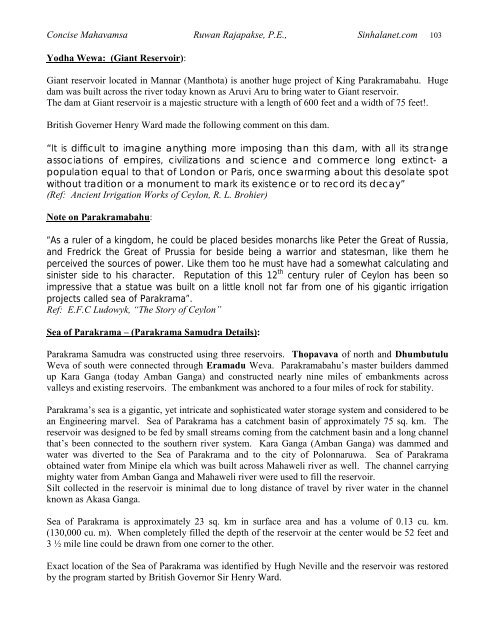Concise Mahavamsa Ruwan Rajapakse, P.E., Sinhalanet.com 1
Concise Mahavamsa Ruwan Rajapakse, P.E., Sinhalanet.com 1
Concise Mahavamsa Ruwan Rajapakse, P.E., Sinhalanet.com 1
Create successful ePaper yourself
Turn your PDF publications into a flip-book with our unique Google optimized e-Paper software.
<strong>Concise</strong> <strong>Mahavamsa</strong> <strong>Ruwan</strong> <strong>Rajapakse</strong>, P.E., <strong>Sinhalanet</strong>.<strong>com</strong> 103<br />
Yodha Wewa: (Giant Reservoir):<br />
Giant reservoir located in Mannar (Manthota) is another huge project of King Parakramabahu. Huge<br />
dam was built across the river today known as Aruvi Aru to bring water to Giant reservoir.<br />
The dam at Giant reservoir is a majestic structure with a length of 600 feet and a width of 75 feet!.<br />
British Governer Henry Ward made the following <strong>com</strong>ment on this dam.<br />
“It is difficult to imagine anything more imposing than this dam, with all its strange<br />
associations of empires, civilizations and science and <strong>com</strong>merce long extinct- a<br />
population equal to that of London or Paris, once swarming about this desolate spot<br />
without tradition or a monument to mark its existence or to record its decay”<br />
(Ref: Ancient Irrigation Works of Ceylon, R. L. Brohier)<br />
Note on Parakramabahu:<br />
“As a ruler of a kingdom, he could be placed besides monarchs like Peter the Great of Russia,<br />
and Fredrick the Great of Prussia for beside being a warrior and statesman, like them he<br />
perceived the sources of power. Like them too he must have had a somewhat calculating and<br />
sinister side to his character. Reputation of this 12 th century ruler of Ceylon has been so<br />
impressive that a statue was built on a little knoll not far from one of his gigantic irrigation<br />
projects called sea of Parakrama”.<br />
Ref: E.F.C Ludowyk, “The Story of Ceylon”<br />
Sea of Parakrama – (Parakrama Samudra Details):<br />
Parakrama Samudra was constructed using three reservoirs. Thopavava of north and Dhumbutulu<br />
Weva of south were connected through Eramadu Weva. Parakramabahu’s master builders dammed<br />
up Kara Ganga (today Amban Ganga) and constructed nearly nine miles of embankments across<br />
valleys and existing reservoirs. The embankment was anchored to a four miles of rock for stability.<br />
Parakrama’s sea is a gigantic, yet intricate and sophisticated water storage system and considered to be<br />
an Engineering marvel. Sea of Parakrama has a catchment basin of approximately 75 sq. km. The<br />
reservoir was designed to be fed by small streams <strong>com</strong>ing from the catchment basin and a long channel<br />
that’s been connected to the southern river system. Kara Ganga (Amban Ganga) was dammed and<br />
water was diverted to the Sea of Parakrama and to the city of Polonnaruwa. Sea of Parakrama<br />
obtained water from Minipe ela which was built across Mahaweli river as well. The channel carrying<br />
mighty water from Amban Ganga and Mahaweli river were used to fill the reservoir.<br />
Silt collected in the reservoir is minimal due to long distance of travel by river water in the channel<br />
known as Akasa Ganga.<br />
Sea of Parakrama is approximately 23 sq. km in surface area and has a volume of 0.13 cu. km.<br />
(130,000 cu. m). When <strong>com</strong>pletely filled the depth of the reservoir at the center would be 52 feet and<br />
3 ½ mile line could be drawn from one corner to the other.<br />
Exact location of the Sea of Parakrama was identified by Hugh Neville and the reservoir was restored<br />
by the program started by British Governor Sir Henry Ward.


